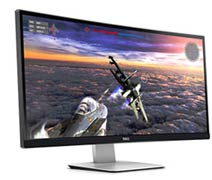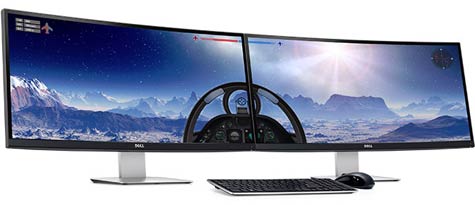Curved TVs are still pretty rare and curved monitors even more so. You’d think that this trend would be focused on entertainment and, in the case of monitors, gamers, but Dell recently unveiled a 34” professional curved monitor, and there is method behind the madness. It suggests there is a lot going on with the professional desktop that we really aren’t paying attention to.
Let me explain.
The Advantage of the Curve
When you curve a monitor, particularly one 34” or larger, you bring the edges into the field of view and you lower the eye strain, because your eyes aren’t having to adjust as radically for the differing distance. Ideally, a curved monitor would place the edges equidistant from the user, who would then sit in the mathematical “sweet spot.” Unfortunately, this isn’t practical for two reasons: Getting that kind of curve affordably is still not doable, and wrapping a monitor around a user would isolate them (although, in some offices, particularly with tiny cubicles, that might be a good thing). But close proximity and isolation hasn’t proven acceptable to most users who want the monitor 1 to 2 feet away from their heads.
Strangely, as a Microsoft study in 2003 found, curved wide monitors work better for women than men for some tasks, because women perceive things on their periphery better than men do. It is theorized that this is because, hundreds of years ago, women gathered food for their families, while men were more focused on hunting. (Some other rather interesting differences in how our brains work are also worth knowing.)
Now, Dell does show this monitor for gaming, but in a dual configuration, which really doesn’t work well, because it puts the edge of the monitor right where your targeting reticle would typically be.
Where It Is Selling
Dell sent me one of these monitors to test and it replaced the 34” LG monitor (WFHD) on my desk that I was using. Basically, the only visual difference was the curve, but this is also a higher resolution (WQHD), and the colors were also deeper. The LG monitor sells for about $500 on Amazon, but the curved Dell sells for about $850. Given, 34” monitors were well into the $2K to $3K range a couple of years ago, so both of these seem like one hell of a deal in comparison.
This Dell curved monitor is a professional monitor, though, and not really geared toward gaming, so I talked to the Dell product manager and asked about where this monitor was selling. This is what I found out.
Reception Areas
I’ve seen this before with cutting edge products. Companies like to put them in reception areas because they signify forward thinking and success. You particularly see this in Asian firms, where status is nearly paramount. This is one of the areas where this product is doing a brisk business, but it isn’t just about appearance—many reception areas used a curved counter and a curved monitor can fit better, particularly if it is installed low, than a straight monitor will.
Executive Use
As you might expect, when an executive walks into a company that’s focused on status and he sees that the receptionist has a better monitor than he does, IT gets a WTF call. So there is a very tight correlation between firms that put these in the reception area and those that put them on executive desks. If executives see this monitor, they tend to want it.
It also actually does a nice job with dashboard products so that you can see both the source document and the one you are working on in a split screen. In fact, with a 34” monitor, you can effectively bring up three projects and work on all three.

One area where this thing has really taken off is in the media and entertainment industries. The curved 34” monitor, while not the most accurate in terms of color, is damn nice for working with audio or video files and animation. Apparently, it adds substantially to their productivity.
Financial Traders
This monitor would typically be used in financial trading as I would use it for gaming—as part of a three-monitor configuration. The 34” curved monitor sits in the middle with two similar resolution smaller monitors bracketing it. Their interests can be easily moved from the side monitors to the middle one as needed and the overall effect is far closer to a surround monitor concept.
Hardware Engineers
With CAD, you don’t really need a great deal of color accuracy, but you do need quite an amount of real estate. Engineers like this monitor a lot, due to having the ability to lay up multiple CAD images, images and pictures, or images and plans at once on a single screen, which would be incredibly handy. Though, I think that if I were doing this work, I’d try to opt for two of these monitors stacked, so I could put my communications apps on the top monitor and leave the lower one for my work. Going much wider than 34” really doesn’t add that much value, but adding a bit of height would make a big difference.
Wrapping Up
It used to be that PCs really drove status, but with folks moving to laptops, small form factor PCs and workstations or simply placing the workstations under the desk, the monitor makes a far stronger statement. But the curve does appear to be attractive for more things than just status, and some of those things are actually legitimate reasons to try out and use this product.
In the end, though, I think this also points out the need for more innovation in the monitor space—particularly targeted innovation. This curved monitor suggests we are now likely to get it.
Rob Enderle is President and Principal Analyst of the Enderle Group, a forward-looking emerging technology advisory firm. With over 30 years’ experience in emerging technologies, he has provided regional and global companies with guidance in how to better target customer needs; create new business opportunities; anticipate technology changes; select vendors and products; and present their products in the best possible light. Rob covers the technology industry broadly. Before founding the Enderle Group, Rob was the Senior Research Fellow for Forrester Research and the Giga Information Group, and held senior positions at IBM and ROLM. Follow Rob on Twitter @enderle, on Facebook and on Google+.




